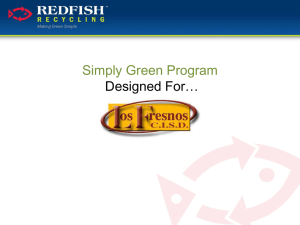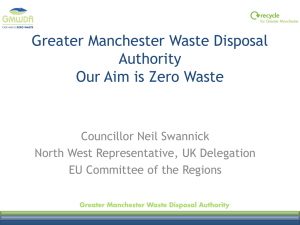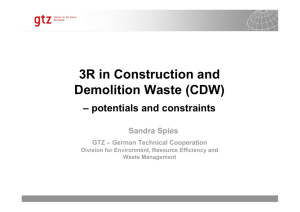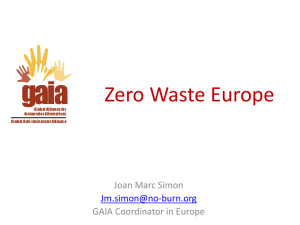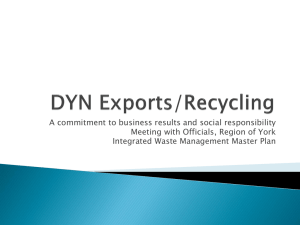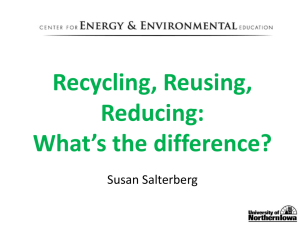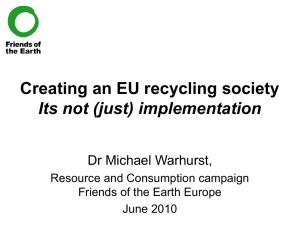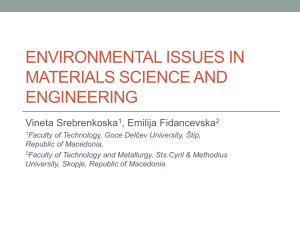CONSTRUCTION AND DEMOLITION WASTE MANAGEMENT
advertisement
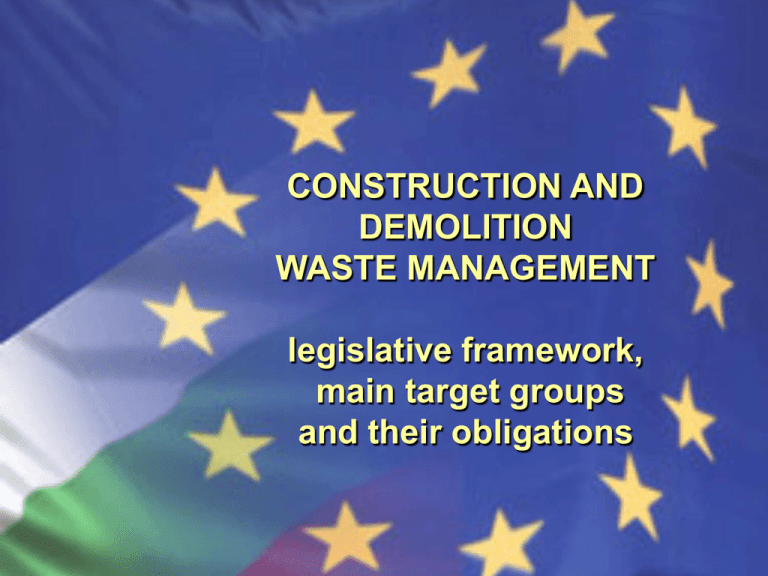
CONSTRUCTION AND DEMOLITION WASTE MANAGEMENT legislative framework, main target groups and their obligations CONTENTS EU CDW FRAMEWORK NATIONAL CDW LEGAL FRAMEWORK IN BULGARIA WASTE MANAGEMENT LAW ORDINANCE ON CONSTRUCTION AND DEMOLITION WASTE MANAGEMENT NATIONAL CONSTRUCTION AND DEMOLITION WASTE MANAGEMENT STRATEGIC PLAN (2011-2020) RECOVERY AND RECYCLING OPTIONS Estimated ranges for the average generation of C&D waste in the EU Bio Intelligence Service, Report 2011; ENV.G.4/FRA/2008/0112 Main drivers in Europe: • EU Waste Framework Directive • Quality and control measures of the EU Landfill Directive EU C&D Legal Framework There is no specific legislation on CDW in EU level WFD – 70% recycling of CDW until 2020 Main waste management principles National legislation and technical standards • Legislative instruments (Contractor/generator responsible principle, obligation to use cdw recycled products, ban for landfilling) • Economic instruments (landfill tax, env. tax for raw material) • Voluntary agreement between government, business and construction industry Estimated ranges of C&D Recycling • > 70 % recycling: Austria, Denmark, Estonia, Germany, Ireland, the UK and the Netherlands • 60 - 70 % recycling: Belgium, and Lithuania • 40 - 60 % recycling: France, Latvia, Luxembourg and Slovenia • < 40 % recycling: Cyprus, Czech Republic, Finland, Greece, Hungary, Poland, Portugal and Spain …BULGARIA • Not sufficient data available: Italy, Malta, Romania, Slovakia and Sweden Bio Intelligence Service, Report 2011; ENV.G.4/FRA/2008/0112 CDW Composition CDW Management policy in Bulgaria . Waste Management Act CDW MANAGEMENT obligations of CONTRACTOR / WASTE PRODUCER for implementation of national targets on CDW recovery – 70% until 2020; until 1 January 2016 г. – at least 35 % until 1 January 2018г. – at least 55 % until 1 January 2020 г. – at least 70% MAYOR of the municipality responsible for the CDW, generated by the households Waste Management Act Introduction of the landfill tax: The aim of the landfill tax is to : • reduce the amount of waste going to landfill • extending the life-time of the expensive facilities such as landfills • increase quantities of recycled and recovered waste • promote alternative methods Waste Management Act The amount of the LANDFILL TAX by the years is as follow: For municipal waste: for 2011 – 1.5 €./t. for 2012 – 4.5 €./t. for 2013 – 7.5 €./t. for 2014 – 17.5 €/t.. For construction and demolition waste: for 2011 – 0.25 €./t. for 2012 – 0.75 €./t. for 2013 – 7.5 €./t. for 2014 – 17.5 €./t. For municipal landfills which do not meet the requirements of legislation the amount of the landfill tax will be double Ordinance on cdw management AIMS Ordinance on cdw management THE SCOPE 1. preventing and reducing air pollution, water and soil and reducing the risk to human health and the environment as a result of treatment and transportation of CDW and use of products derived from recycling of CDW 2. introduction and implementation of environmentally sound management and waste management control; 3. introduction of end of waste status and environmental requirements to be met by products derived from recycling CDW; 4. obligations for relevant entities related to the CDW management. OBLIGATIONS - Regarding to the WFD the ORDINANCE sets a target of 70% of preparation for re-use, recycling, and other forms of material recovery of C&D waste, including backfilling until 2020. Ordinance on cdw management BARRIERS AND DRIVERS TOWARDS THE 70% TARGET Economic barriers: High availability and low cost of raw materials •The main corresponding policy option to overcome this is making landfilling of waste unattractive, by introducing a ban or high levies on landfilling Cultural barriers: Misconception of the quality of recycled products •Turning waste into a valuable raw material: this can be achieved through quality certification of secondary raw material from C&D waste •Communicating on the benefits of secondary raw material •Development of end-of-waste criteria •Green Public Procurement (GPP) Technical barriers: ineffective sorting and contamination of the waste flow •Encourage the sorting of C&D waste “at source” •Selective demolition / controlled deconstruction Ordinance on cdw management MAIN REQUIREMENTS selective deconstruction of buildings with separation of the main components separation of waste materials during the execution of construction and repair works; recycling of concrete , ceramics , asphalt and mineral components (Implementation of Targets 70% until 2020 implementation of CDW recycling products in infrastructure projects. for construction of buildings - 2 % from total amount of construction products; road construction - 10 %; renovation works – 3%; Ordinance on cdw management MAIN REQUIREMENTS CDW MANAGEMENT PLAN general information about the investment project -Annex № 2; description of the demolition object -Annex № 3 ; forecast CDW generation and the level of material recovery Annex № 4; estimates of the type and quantity of CDW recycling products implemented during the project - Annex № 5; measures to be taken relative to the CDW management TRANSPORT BOOK Information for those who carry out the transportation of CO and – Annex 6 persons who are transferred to CO process works and removal. Ordinance on cdw management MAIN REQUIREMENTS Specific waste stream recovery targets for every projects 17 01 01 concrete - 85%; 17 01 02 bricks- 70%; 17 01 03 tiles - 70 %; 17 02 01 wood – 80%; 17 02 02 glass– 80%; 17 02 03 plastics– 80%; 17 03 02 asphalt– 80 %; 17 04 01 metals– 90 %; Specific CDW recovery targets for road and rail road construction sector – 80% Ordinance on cdw management Requirements do not apply to: demolition of buildings with a gross floor area less than 100 square meters reconstruction and renovation of buildings with an area less than 500 square meters renovation of use of buildings with an area less than 500 square meters Building with an area less than 300 square meters; remove unusable or unsafe buildings, as ordered by the emergency authority NATIONAL CONSTRUCTION AND DEMOLITION WASTE MANAGEMENT STRATEGIC PLAN 2011-2020г. Measures for implementation of the strategic plan ADMINISTARTIVE - introduction of “green public procurement (GPP) criteria”; - including recovery and recycling activities as a part of the National certificate construction system ; - identifying the main obligations and responsibility to the CDW generators: site waste management plan, achievement of the recycling targets, special requirements for construction design, requirements for selective demolition of buildings ECONOMIC AND TECHNICAL - increasement of landfill tax; - implementation of quality assurance system for the products, produced from recycled cdw - Establishing a network of facilities for cdw treatment, producing recycled material with guaranteed quality NATIONAL CONSTRUCTION AND DEMOLITION WASTE MANAGEMENT STRATEGIC PLAN 2011-2020г. Description of cdw management scenario selective demolition of buildings; separate collection; high quality recycling of main streams – concrete, asphalt, ceramics, wood, plastic, metals and glass; Main priority - construction of entire needed infrastructure for cdw recycling and quality assurance of the final products, including achievement of high cdw recycling level NATIONAL CONSTRUCTION AND DEMOLITION WASTE MANAGEMENT STRATEGIC PLAN 2011-2020г. THE RESULTS improvement of the legal framework, related to the CDW management; Ensuring national CDW management approach – national conception; achievement of the 70% cdw recycling targets until 2020 increasing the investment in cdw management sector; saving of natural resources, Treatment of CDW RECOVERY AND RECYCLING OPTIONS CONCRETE Applications in the construction sector :Buildings, roads, infrastructure Treatment options: . -landfill , - recycling into aggregates for road construction or backfilling, - recycling into aggregates for concrete production, -re-use of precast elements (concrete blocks) BRICKS, TILES AND CERAMIC Applications in the construction sector : - Brick: masonry construction especially for building and - Tile: covering of roofs, floors and walls \ Treatment options : -landfill , - recycling (replaces sand, gravel, stones, rocks e.g. to fill roads, to produce tennis sand, to serve as aggregate in concrete) , -re-use RECOVERY AND RECYCLING OPTIONS ASPHALT Applications in the construction sector : Pavement for road construction . and maintenance Treatment options : - landfill, - recycling in a stationary plan, - in-situ, recycling, material recovery WOOD Applications in the construction sector :Roof structure, building framework, floors, doors, etc. Treatment options : - landfill - recycling into derived timber products, - energy recovery RECOVERY AND RECYCLING OPTIONS GYPSUM Applications in the construction sector : Buildings . Treatment options : - landfill - recycling into new plasterboards (In substitution of natural gypsum or In substitution of synthetic gypsum) HAZARDOUS SUBSTANCES PRESENT IN C&D WASTE Ozone depleting substances (ODS) - Applications in the construction sector :Blowing agent for plastic insulating material in buildings - Treatment options : landfill, incineration, removal of ODS and recycling or re-use of other materials RECOVERY AND RECYCLING OPTIONS Hazardous substances: asbestos, lead based paints (LBP), phenols, Polychlorinated Biphenyls (PCB) and Polycyclic Aromatic . Hydrocarbons (PAH) LBP (LEAD BASED PAINTS) - Treatment options : Lead was added to paint as pigment but also added to speed drying, increase durability, retain a fresh appearance and resist moisture that causes corrosion. PHENOLS - Treatment options : Treated wood and insulation panels containing phenol can be treated by removing the contaminated surface area and then recycled by reintroducing them in the manufacturing process. Other phenol contaminated C&D waste is disposed of in landfills. RECOVERY AND RECYCLING OPTIONS PCB (POLYCHLORINATED BIPHENYLS ) .- Treatment options : Disposal of waste products containing PCBs include: Decontamination i.e. decolouration, which is the treatment for the chemical decomposition of chlorine molecules ; C&D waste contaminated with PCBs can also be incinerated (with special flue gas treatment); storage PAH (POLYCYCLIC AROMATIC HYDROCARBONS) - Treatment options : Such waste are generally mixed with other products during the demolition step and landfilled. PAH contaminated C&D waste are disposed of in hazardous waste landfills. Leachate from landfills may contain PAH and are treated to avoid contamination. C&D waste contaminated with PAH can also be incinerated (with special flue gas treatment). RECOVERY AND RECYCLING OPTIONS CDW RECYCLING VALUES . • saving the natural resources; • low material consumption; • low transport costs; • low emissions; • low cost for landfilling; • preserve the environment and human health. FUNDING OPTIONS . • STATE BUDGET • MUNICIPALITY BUDGET • PUBLIC PRIVET PARTNERSHIPS AND ETC EUROPEAN UNION EUROPEAN REGIONAL DEVELOPMENT FUND COHESION FUND THANK YOU FOR YOUR ATTENTION! MINISTRY OF ENVIRONMENT AND WATER OF BULGARIA
